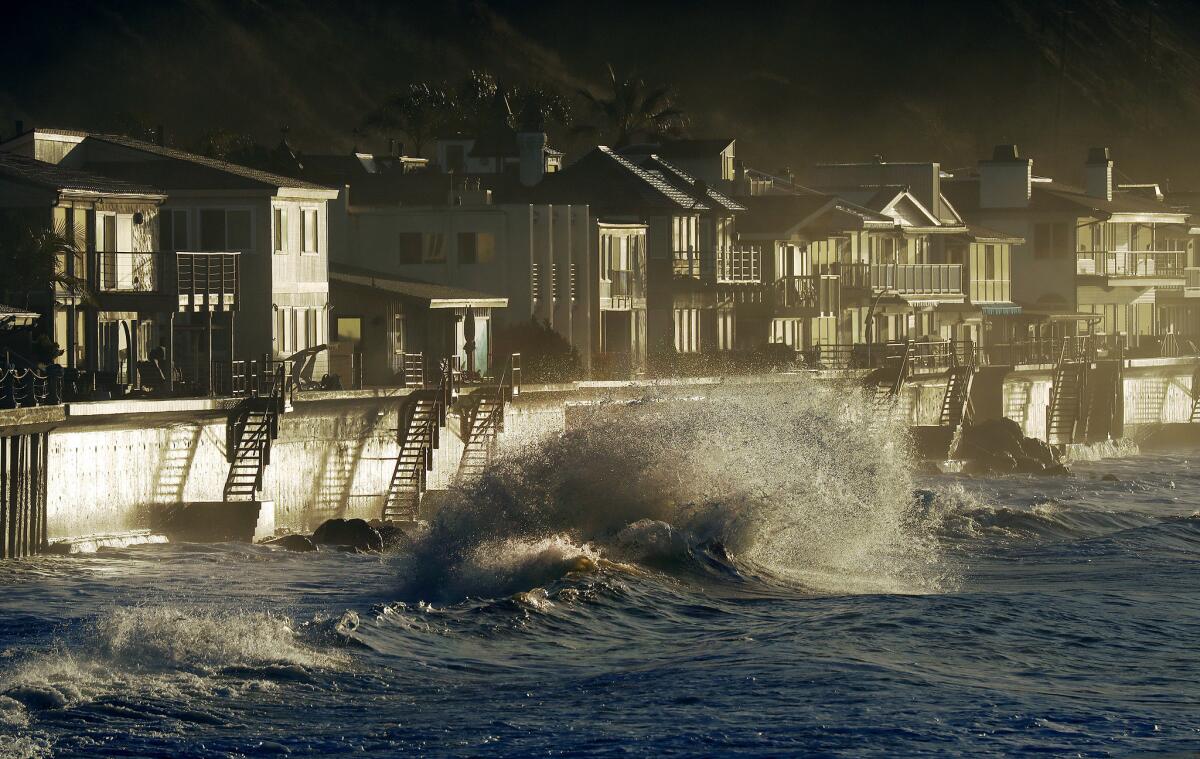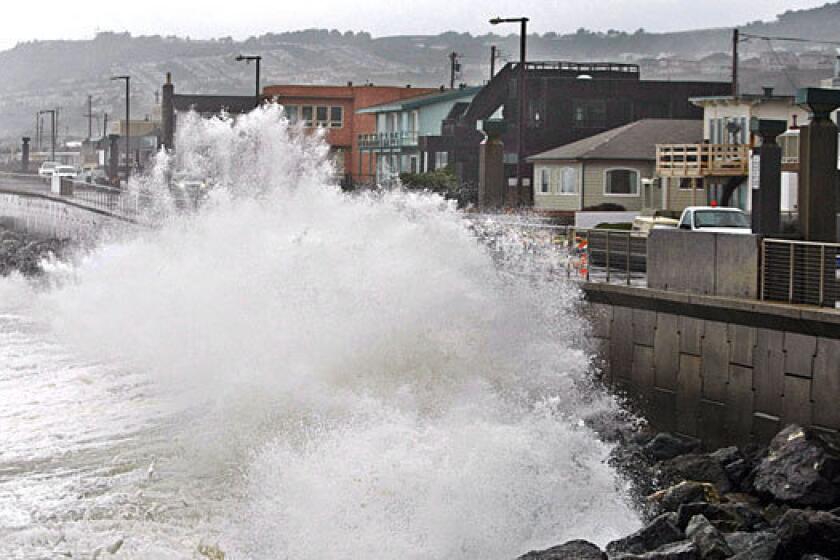California officials need to move faster on sea level rise, legislative study finds

- Share via
In one of the most comprehensive assessments of the crisis that rising seas pose to California, an influential state panel on Tuesday urged local officials to take ownership of the issue and lawmakers to move fast and consider much-needed legislation.
The Legislative Analyst’s Office, a nonpartisan arm of the state Legislature that lawmakers turn to for fiscal and policy advice, found that the state was already behind on the issue and made the case that any action — or lack of action — within the next 10 years could determine the fate of the California coast.
In just the next decade, the sea could rise more than half a foot — with heavy storms and cycles of El Niño projected to make things even worse.
Critical roads and infrastructure are already mere feet from toppling into the sea and homes are flooding, but cities up and down the coast have been paralyzed by the difficult choices ahead. Failure to act will result in lost opportunities to be proactive — and much higher costs, the report concluded.
“Progress of sea level rise preparation across the state’s coastal communities has been slow,” the report said. “Coastal communities must increase both the extent and pace of sea level rise preparation efforts if California is to avoid the most severe, costly, and disruptive impacts in the coming decades.”
The report serves as a road map for lawmakers as they think about bills and budget priorities for next year.
The recommendations come at a time when California is waking up to the reality that so many of its communities and critical infrastructure are built right to the water’s edge. Just last week, a special committee of California lawmakers had gathered for the first time in five years to revive this discussion on sea level rise and what the state needs to do to better prepare coastal communities from devastating loss.
More than $150 billion in property could be at risk of flooding by 2100 — the economic damage far more devastating than the state’s worst earthquakes and wildfires. But connecting the dots across a state whose coastline spans 1,200 miles has proved to be difficult.
“The goal was to be really clear on the issue — and focus on specific actions and concrete steps to make faster progress on sea level rise,” said Rachel Ehlers, lead author of the legislative report.
Analysts urged lawmakers to adopt legislation, for example, that requires a real estate disclosure, or “vulnerable coastal property statement,” for properties that are in areas at risk of flooding from sea level rise.
Similar to mandatory disclosures for properties in fire and earthquake zones, requiring this information would lull more people out of a false sense of safety — and inform buyers of what the California coast is up against in future decades.
Uncertainty about just how much — and how fast — the sea will rise is not a reason to withhold critical information from the public, the report said. “The state has already determined that, despite the inherent uncertainty, alerting purchasers when a property faces a potential risk of future damage from earthquakes, fires, or floods is important public policy.
“Indeed,” the report added, “the case for coastal disclosures is arguably even stronger since the certainty of some amount of sea level rise occurring is greater than that associated with threats such as earthquakes.”
The report’s authors found that responding to sea level rise was not yet a priority for many coastal residents and local elected officials — and much of that is rooted in a general lack of awareness.
Analysts reviewed numerous scientific studies and conducted more than 100 interviews with local governments, state and federal agencies, academic researchers, community groups and nongovernmental organizations. They studied existing state laws relevant to this issue, looked at why local governments weren’t making more progress and identified all the state agencies with a responsibility to address the issue.
They discovered that even in the cities and counties that were trying to study the risks, many people were paralyzed on how to move forward. Cities need more funding to do such large-scale planning into the future, and climate adaptation is such uncharted territory that a lot of planning officials are learning about the issue as they go.
“Having someone to call — we heard that over and over again,” Ehlers said. “They want to be able to talk to experts and other people and ask: What have you tried? What works? What doesn’t work? What are some of the issues we should think about?”
So the report proposes a climate adaptation and regional support network — a center, perhaps, staffed by 20 people, rather than just another website with a bunch of information and links — for providing this much-needed technical support to local governments. Sharing ideas and thinking more regionally is critical, Ehlers said.
“This way, each city, each county, does not feel like they’re out there by themselves trying to figure this out,” she said. “And we’ve got to get cross-jurisdictional partnerships happening. It’s essential. The effects of sea level rise don’t stop at the county line. And the actions of one city impacts the next city. If one really armors [their coastline], then the beaches are gone in the next.
“We have to work together … and think about the entire coastline.”
Lawmakers so far have shied away from issuing mandatory directions. The California Coastal Commission, through modest grants and some general guidance, has been encouraging local officials to consider every strategy — including the controversial option of relocating oceanfront properties and critical infrastructure away from the water — when updating city policies.
These battles between coastal officials and local leaders over the shoreline’s future have played out in places such as Del Mar, where a lack of statewide action has led many communities to believe what happens in these small towns will set the precedent across California.
Jack Ainsworth, executive director of the coastal commission, said his agency was still reviewing the new report but welcomed the comprehensive analysis and interest from lawmakers to do something about this “existential crisis … and the planning challenges ahead.”
Competing priorities will be tricky — state and local officials must weigh the need to protect critical infrastructure, seaside communities, beaches and other public resources. Also vying for funding and attention are wildfires, homelessness, the pension crisis and other issues pressing the state.
Sea level rise, the Legislative Analyst’s Office reported, will complicate the state’s housing priorities. Looking ahead, some existing units along the coast will be flooded regularly and become uninhabitable. Other parcels of land that may seem prime for development right now, might be flooded in future decades.
“California faces a serious housing shortage, and the state’s coastal areas are experiencing the most acute population growth, high housing costs, and demand for more affordable housing,” the report said. “Our office has estimated that on top of the 100,000 to 140,000 housing units typically built in the state each year, California probably would have to build as many as 100,000 additional units annually — almost exclusively in its coastal communities — to seriously mitigate housing affordability problems.”
Smart planning must happen now, the report said, to account for this growing demand but loss in available land.
It’s now up to state lawmakers to act on these recommendations. The Assembly’s Select Committee on Sea Level Rise and the California Economy, which was revived this year by Assemblywoman Tasha Boerner Horvath (D-Encinitas), is expected to discuss this report before the start of next year’s budget talks.
So much is at stake, she said, and the Legislature needs to figure out how to prioritize.
“The problem is, if you tell people there’s a danger and you don’t have concrete solutions, people get very anxious,” Boerner Horvath said. “What does this mean for me and my property value? Or me and my kid’s school? Or me and how I’m going to get to work every day on the train?
“If you don’t have those answers … what does that ambiguity leave for the people of California?”
More to Read
Sign up for Essential California
The most important California stories and recommendations in your inbox every morning.
You may occasionally receive promotional content from the Los Angeles Times.













